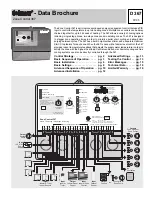
3
At the start of the night setback period the heat is turned off, but the heat
contained within the slab or radiator continues to heat the building and
there is a delay before the space temperature begins to drop. At the end
of this delay the temperature within the building gradually decreases, and
may eventually reach the required UnOccupied temperature after suffi-
cient time has elapsed. Once the setback period is complete, the heat is
turned on again but there is a long recovery time required to raise the
space temperature to the desired setpoint. The length of the delay and
recovery periods changes with outdoor temperature and is different for
each zone within the building.
A comfortable setback can be provided if the control “learns” the
response time for each zone within the building. Based on the zone’s
response time, the control can then calculate an Optimum Stop time and
an Optimum Start time. At the Optimum Stop time the control turns off the
zone valve or pump in order to overcome the delay period and at the
Optimum Start time, the control starts to raise the zone temperature in
order to overcome the recovery period. This allows night setback to be
used with most heating systems.
Optimum Start / Stop with Water Temperature Boost
When Optimum Start / Stop is combined with Outdoor Reset, the
control can boost the water temperature during the recovery period.
This provides a faster recovery and allows a longer setback for greater
energy savings.
The accuracy of the Optimum Start / Stop routine depends on the
feedback available to the control.
Optimum Start / Stop with both Outdoor and Indoor Sensors
The response time of the building varies with outdoor temperature and is also different
for each zone. The most accurate Optimum Start / Stop routine is therefore achieved
when both the indoor and outdoor temperatures are monitored during transitions between
UnOccupied and Occupied modes.
Optimum Start / Stop with only Indoor Sensors
When only indoor temperature feedback is available, the control must base all Optimum
Start / Stop calculations on
indoor temperature only. If there are large variations in outdoor
temperature, this method cannot provide the same level of accuracy as when both indoor
and outdoor sensors are used.
Optimum Start / Stop with only an Outdoor Sensor
Every building, and often each zone within the building, has a different response time.
When only an outdoor sensor is used, the control must assume a particular response time
for the entire building. Therefore this is generally the least accurate method of calculating
Optimum Start / Stop times.
Basic Sequence of Operation
To use the basic features of the control, the DIP switches must be set to
One & Two Stage and Zone 2 Heating and the Design Outdoor dial must
be set to Off . More advanced features including modulating zones, free
cooling and demand limiting are explained on page 10.
POWERING UP THE CONTROL
After the Zone Control 367 is powered up, a software version code is displayed for 2 seconds
and then the red indicator lights are then turned on for 4 seconds. When the control is
powered up, the green
Power light remains on continuously. For the first fifteen minutes
after power up, the
Test light flashes and the control responds immediately to changes of
settings. This allows the installer to test the operation of the system. After fifteen minutes,
the control enters its normal operating mode in which reactions to setting changes are
significantly slower. A slower reaction time to setting changes allows the control to provide
a more stable room temperature.
Only in the first 15 minutes after power up, does
the control respond immediatley to settings
adjustments.
70
M
Test
Delay
Period
5 A.M.
9 P.M.
10 P.M.
8 A.M.
Room Temperature
Setback Period
Optimum
Stop
Recovery
Period
Optimum
Start
Occ
70
°
F
(21
°
C)
UnOcc
65
°
F (18
°
C)
Delay
Period
6 A.M.
9 P.M.
10 P.M.
8 A.M.
Room Temperature
Setback Period
Optimum
Stop
Shorter
Recovery
Period
Optimum
Start
UnOcc
65
°
F (18
°
C)
Occ
70
°
F
(21
°
C)
Delay
Period
8 A.M.
10 P.M. 11 P.M.
11 A.M.
Recovery
Period
Setback Period
Occ
70
°
F (21
°
C)
UnOcc
65
°
F
(18
°
C)
Zone 2 Heating
One & Two Stage
0
°
F
-40
Off
Design Outdoor
30
Outdoor
Sensor
Room
Temperature
Units (RTU's)
Room
Temperature
Units (RTU's)
Outdoor
Sensor


































